LD Systems DDQ12 – Test Report by PRODUCTION PARTNER
Good components and a complex signal path are no longer solely big-ticket features: the DDQ12 is an active 2-way speaker with high-quality drivers and a built-in DSP system, and we put its capabilities to the test.
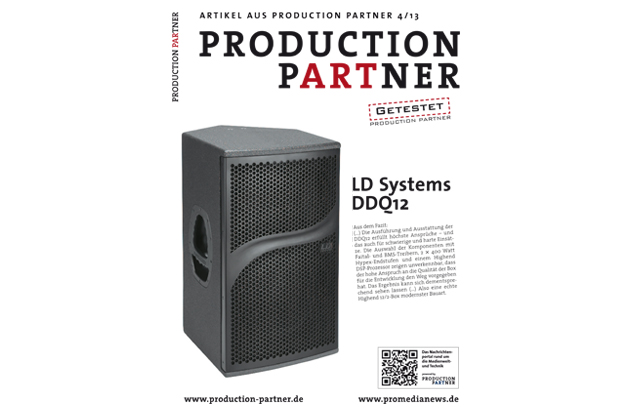
LD Systems, a sales brand of Adam Hall, offers a whole string of professional audio equipment. This includes numerous speakers, amplifiers, mixers, and various peripherals. When the series debuted in February 2013, the active speakers of the DDQ Series were added, of which the DDQ12 12/2 speaker will be presented here. In general, LD Systems products are known as affordable components for musicians, small rental agencies, clubs, and discos.
The aim of the completely re-engineered DDQ Series is to stay the course in terms of “affordability” while otherwise aiming for what is technically feasible. This calls for high-quality drivers, modern, high-performance PWM power amplifiers, and a good DSP controller. All of this, well designed and housed in a solid cabinet, should offer all of the prerequisites for a speaker that need not fear any comparison with the “big” names in the industry. Starting with the drivers, Adam Hall already has two brands in its portfolio, BMS and Faital Pro, that surely fit the bill. For the power amplifiers and power supplies, LD Systems turned to the products of the Dutch specialist Hypex, which enjoy an outstanding reputation even in high-end circles. That leaves the subject of filters and limiters, an area where “digital” is clearly the sign of the times, leading the folks at LD Systems to decide during the development phase to develop a DSP board of their own based on a Sharc processor.
The electronics, the chassis or even the entire speaker would have probably also been available in an outwardly similar form for very little money on the Far Eastern market. In the long run, however, quality at all levels is the only thing that helps when you are trying to set yourself apart from the mass market. Manage to accomplish this at an affordable price as well, and the outlook is bright. In the following, we intend to examine whether and to what extent LD Systems succeeded in doing this.
Cabinet and drivers
The DDQ12 is loaded with a Faital 12″ woofer and a 1″ HF driver by BMS. The woofer uses a neodymium driver while the tweeter has a ferrite magnet. This combination seems expedient for two reasons. It is possible to save an especially large amount of weight by using the neodymium magnets in the woofer, which makes the use of the modern magnetic material very practical. Where the tweeters are concerned, the reduction in weight would be relatively low. Thus it was decided to stick with ferrite magnets, which make the tweeters even more resilient against overloading thanks to their much higher thermal capacity. In the DDQ12, the 1″ tweeter is used with an asymmetrical and rotatable 80 x 50 horn. In the normal upright position, the horn radiates wider downwards. This means that coverage of the area near the speaker is broader than coverage of the more remote area, as befits a real-life stage situation with an audience. When the speaker is used on its side as a floor monitor, the horn can be rotated by 90° so that the broad side radiates upward and the narrow side radiates downward. To do this, it is easy to detach the horn mount, which is fastened with four screws.
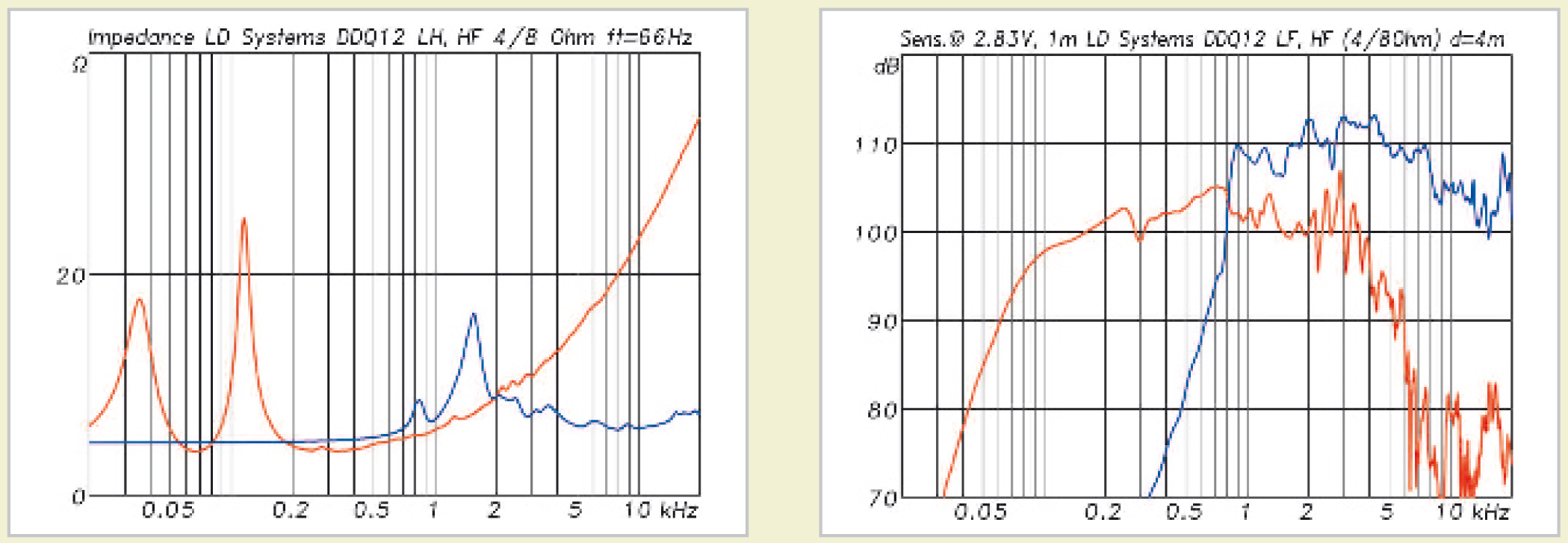
Fig. 1: Impedance curves of the two paths. The woofer (red) is a 4Ω system for improved utilization of the power amp. The bass-reflex cabinet is tuned to 66 Hz.
Fig. 2: Frequency response and sensitivity of the two paths without controller. Both paths were measured for 2.83 V. Thus the 1 W / 1 m sensitivity of the woofer is 3 dB lower than shown here.
The cabinet of the DDQ12 is very solidly constructed of multiplex and has a sturdy front grille that wraps around the front edges to protect them. The recessed handle on the side is generously proportioned and makes it easy to handle the cabinet, which is still relatively light at 17 kg. The base of the DDQ12 has a built-in pole mount with an adjustable tilt angle of ±13.5° in 4.5° increments. It makes it possible to aim the cabinet simply and reliably. There are recessed rubber feet in the base and on one side for horizontal use as a floor monitor. Moreover, a complete range of accessories, including protective covers, wall mounts, and swing brackets, is available to meet every need. The woofer of the DDQ12 acts on a bass-reflex cabinet that is tuned to 66 Hz, so the speaker is also well-suited for use as a full-range system. The associated impedance curve in Fig. 1 (red curve) indicates that the woofer is a 4Ω system and the tweeter is an 8Ω system. A 4Ω chassis was chosen for the woofer in the interest of improved utilization of the power amps.
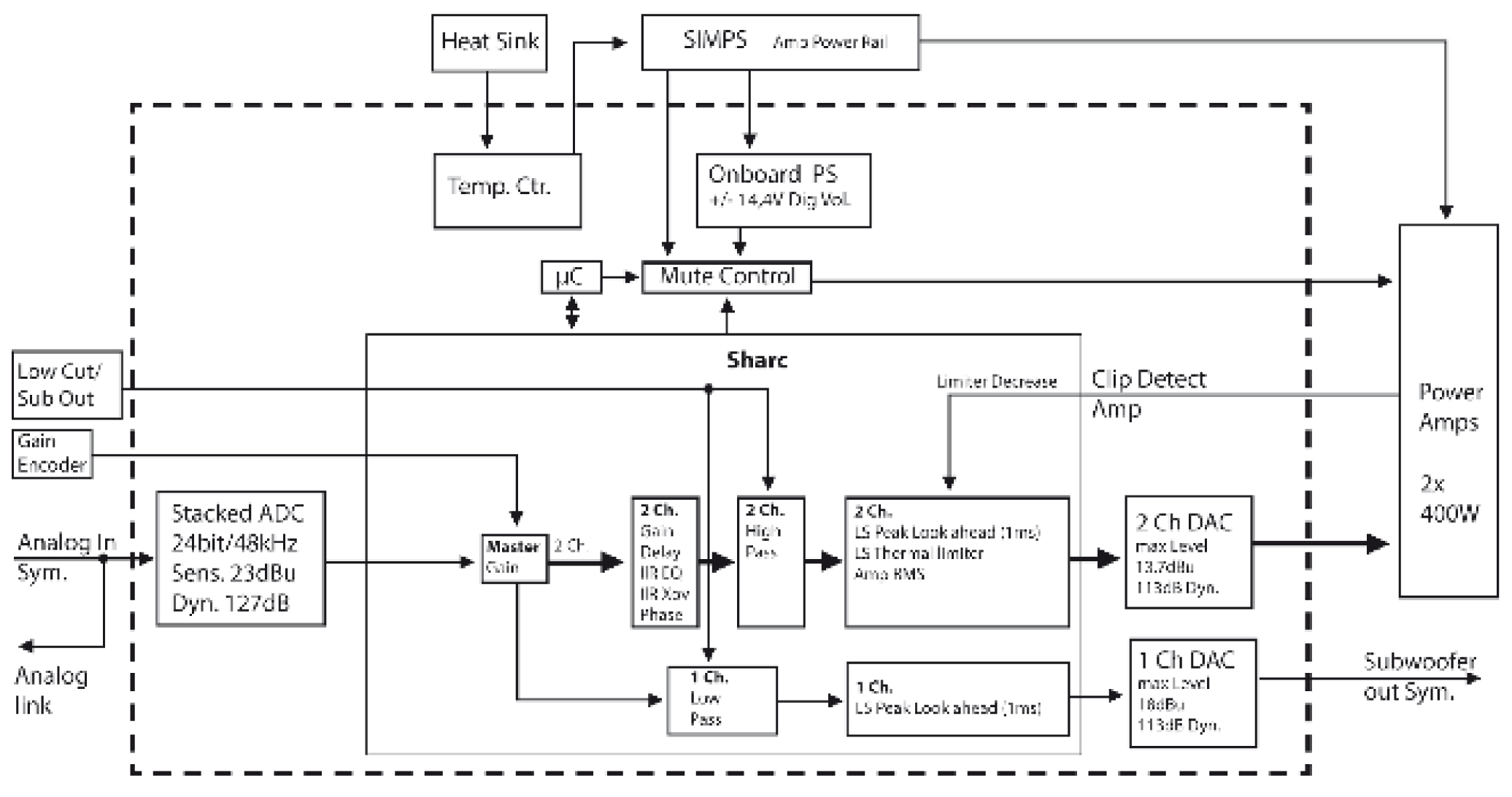
Fig. 3: Block diagram of the internal electronics
When it comes to frequency response measurement, both systems demonstrate high sensitivity. Even after deducting 3 dB for the woofer because of the 2.83 V measurements for a 4Ω chassis, the mean sensitivity between 100 Hz and 10 kHz is almost 99 dB 1 W / 1 m. Midway between 1 and 10 kHz, the tweeter attains an average 109 dB. Apart from this, there are no peculiarities in the frequency response curves of the LF and HF paths. This means that it is easy to trim the speaker to a linear frequency response without a lot of filtering, which makes for a very good place to start.
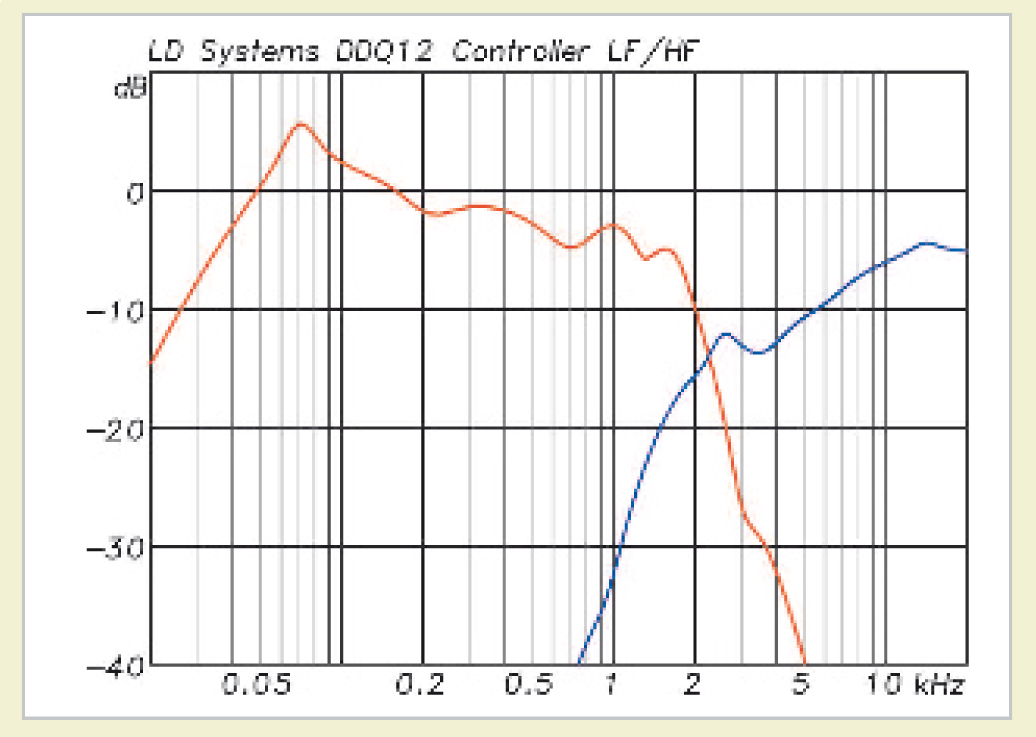
Fig. 4: Filter functions of the internal DSP controller. For the woofer, a 2nd order high-pass filter is used for protection against low frequencies below the tuning frequency.
Electronics
The electronics of the DDQ12 are recessed on the rear of the cabinet and can be removed as a unit if necessary, for example, if they require servicing. The space behind the electronics is a separate housing that is completely sealed off from the woofer enclosure. This prevents premature damage to the electronics through vibration and possible microphonic effects. The mains connection is a lockable IEC socket. For the audio signal, there is an XLR socket with link output and an additional output for an external subwoofer. If the “subwoofer” setting is activated, a high-pass filter at 100 Hz (Butterworth 18 dB) is inserted in the signal path of the DDQ12 and the corresponding low-pass filter is activated in the output for the subwoofer. An additional switch activates the ground lift. A total of four LEDs indicate Signal Present, Peak-Limit, Subwoofer Mode, and Operate.
The analogue input of the DDQ12 is designed for levels up to a maximum of +23 dBu, which offers adequate security against overloading for all everyday applications. A digital gain of –34 to +23 dB can be set using a rotary encoder. When the encoder is set to 0 dB, the speaker attains full saturation with +23 dBu at the input. In the +23 dB gain setting, full saturation is attained with 0 dBu at the input, in which case even sources with a weak level are sufficient. The wide gain range with a fixed analogue clipping threshold of +23 dBu is made possible by a stacked A/D converter in the input with a 127 dB dynamic range, without any noise problems. In the signal processing section, the A/D converter is followed by the X-over filters and EQs as IIR filters, as well as delay and phase adjustments between tweeter and woofer. Fig. 4 shows the filter functions provided here for the LF and HF paths. There is an unobtrusive boost for the woofer above the tuning frequency at 70 Hz. Below this, a 2nd order high-pass filter takes effect. The separation between tweeter and woofer takes place at approx. 1,500 Hz.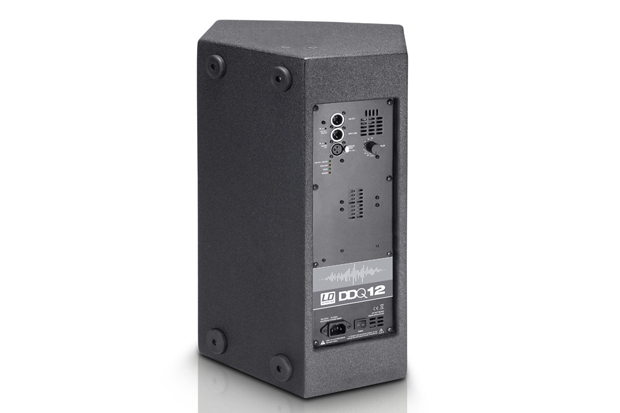
Fig. 5: The rotary encoder can be used to set a digital gain of -34 to +23 dB.
After the filters come the limiters. There is a predictive peak limiter for each output, an RMS limiter for the power amplifiers, and a thermo-limiter for the drivers. The predictive limiter uses a short delay of 1 ms, so that it is always possible to intercept impending overdriving with precisely the right attack after this 1 ms. In terms of tone, these limiters are especially unobtrusive. In their brochure, LD Systems describe this as “quality 1 millisecond ahead …”, which sums it up concisely.
The big difference is that a normal limiter can never intervene until overdriving is already occurring. Then the only remedies that remain are to either cut off the signal abruptly or permit clipping (overshoot). With the predictive structure and the short delay, both are eliminated. The Dutch manufacturer Hypex is responsible for the power amplifiers and power supply technology. The power amplifiers deliver 420 W at 4Ω and 225 W at 8 Ω, thus permitting good utilisation of both drivers. The other key data of the Hypex power amplifiers include an outstanding signal-to-noise ratio of 110 dB, an attenuation factor of 100 (referring to 4Ω), and minimal distortion. So there is a reason why Hypex power amplifiers also turn up in some rather expensive hi-fi equipment. The low losses are another plus, enabling the DDQ12 to make do without a visible heat sink. To avoid heat build-up inside, a slowly rotating fan inside the inner housing for the electronics ensures sufficient air circulation.
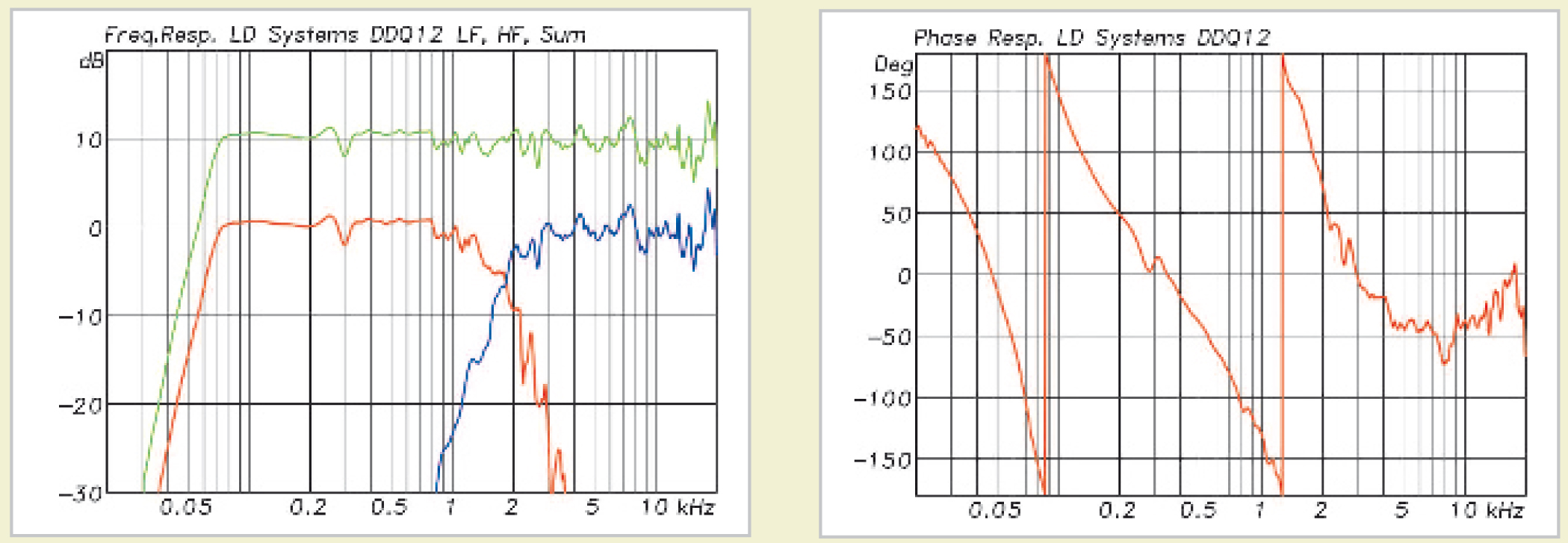
Fig. 6: Frequency response of the DDQ12 overall (green) and both the LF (red) and HF (blue) paths
Fig. 7: Phase response of the DDQ12. The transition occurs in the sum of electrical and acoustic filters on the 4th order. At the low end of the frequency band, the phase shifts by 360° due to the bass-reflex cabinet and by an additional 180° due to the electrical high-pass filter.
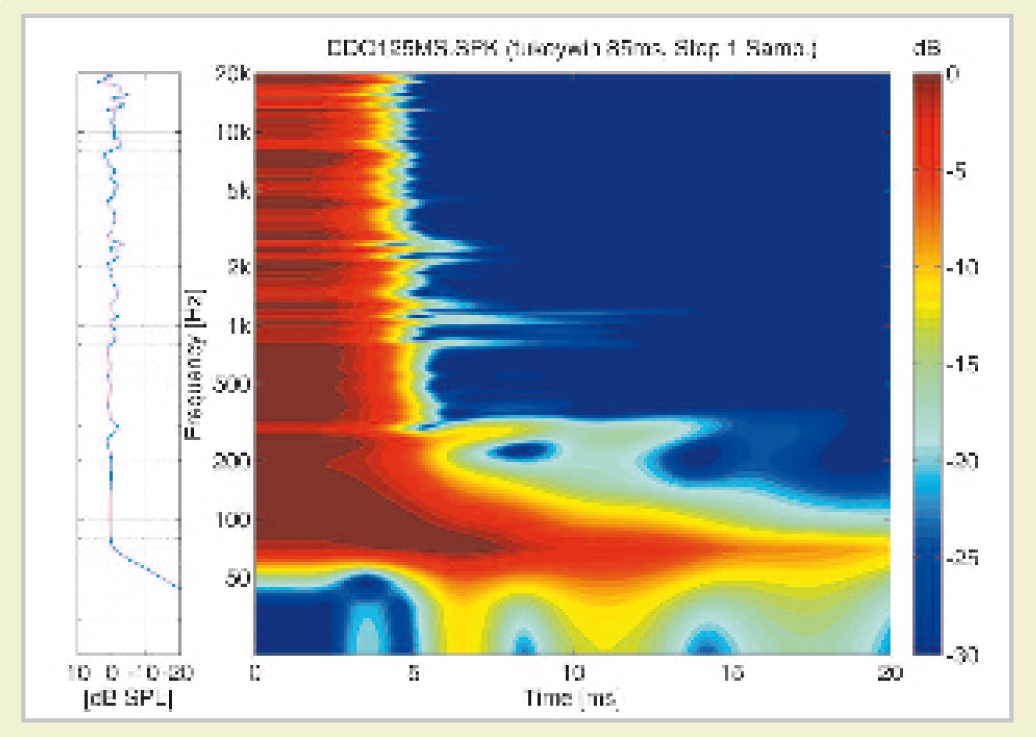
Fig. 8: Spectrogram of the DDQ12. Some small resonances can be seen in the mids. There is a cabinet mode at 300 Hz.
Measured values
Now let’s take a look at the measured values of the DDQ12 as a whole. Figure 5 shows the frequency response and the individual contributions of the treble and bass path, which add up nicely in the transition range. On the whole, the course of the cumulative curve is very nicely consistent with a transmission range of 60 Hz to 20 kHz based on the – 6 dB points. A ±2 dB ripple in the overall course with a completely non-smoothed representation also scarcely requires any additional explanation. You don’t see a frequency response curve like this every day. The associated cumulative curve phase response in Fig. 6 shows the minimum-phase components of the X-over function (360°), the bass-reflex enclosure as a 4th order acoustic high-pass filter (360°), and the additional 2nd order electrical high-pass filter (180°). The spectrogram of the DDQ12’s cumulative response curve shown in Fig. 7 reveals a few minor resonances in the mids and a cabinet mode at 300 Hz. Regarded absolutely, however, these resonances are on entirely harmless scales. The tweeter, with the ring diaphragm that is typical for BMS, does its job absolutely flawlessly up to 20 kHz.
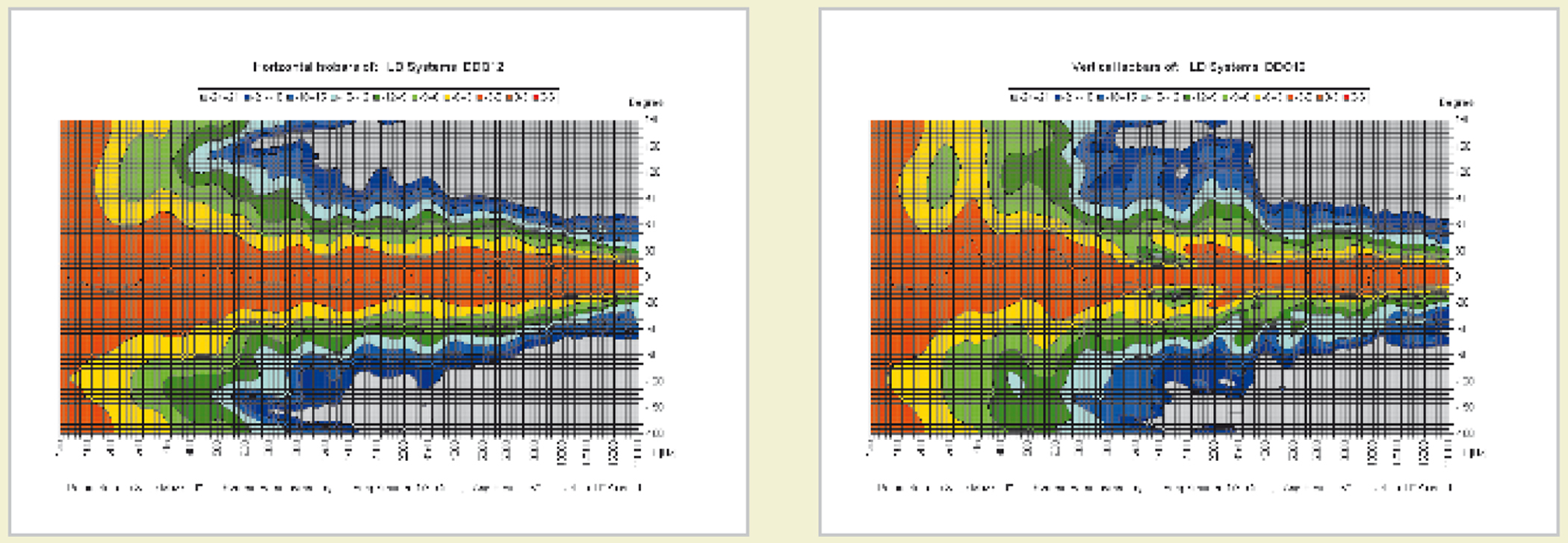
Fig. 9: The DDQ12, which is specified at 80 x 50, attains the horizontal angle from approx. 800 Hz upwards. Above 8 kHz, there is then a slight constriction in the isobars.
Fig. 10: Vertical isobars of the DDQ12. The nominal 50° are attainedfrom approx. 4 kHz upwards. The interference in the transition range is moderate.
Directivity
In the data sheet, the dispersion pattern of the DDQ12 is stated to be 80 x 50 asymmetrical. If one moves through the vertical plane in front of the enclosure from bottom to top, the horizontal dispersion angle attained becomes narrower from bottom to top. Figs. 8 and 9 show the isobars with reference to the central axis of the enclosure. Horizontally, 80° is attained starting from approx. 800 Hz upwards and is then maintained up to 8 kHz. Above this, slightly increasing bundling begins. Vertically, the nominal 50° reading is attained from approx. 4 kHz upwards. The interference in the transition range is moderate. Besides the –6 dB aperture angles, an even drop-off in level outside of the central axis is also important for a homogenous auditory impression. For the isobars, this means that the course of the lines should be as uniform as possible over a wide frequency range, which is accomplished in exemplary fashion here for a speaker of this size.
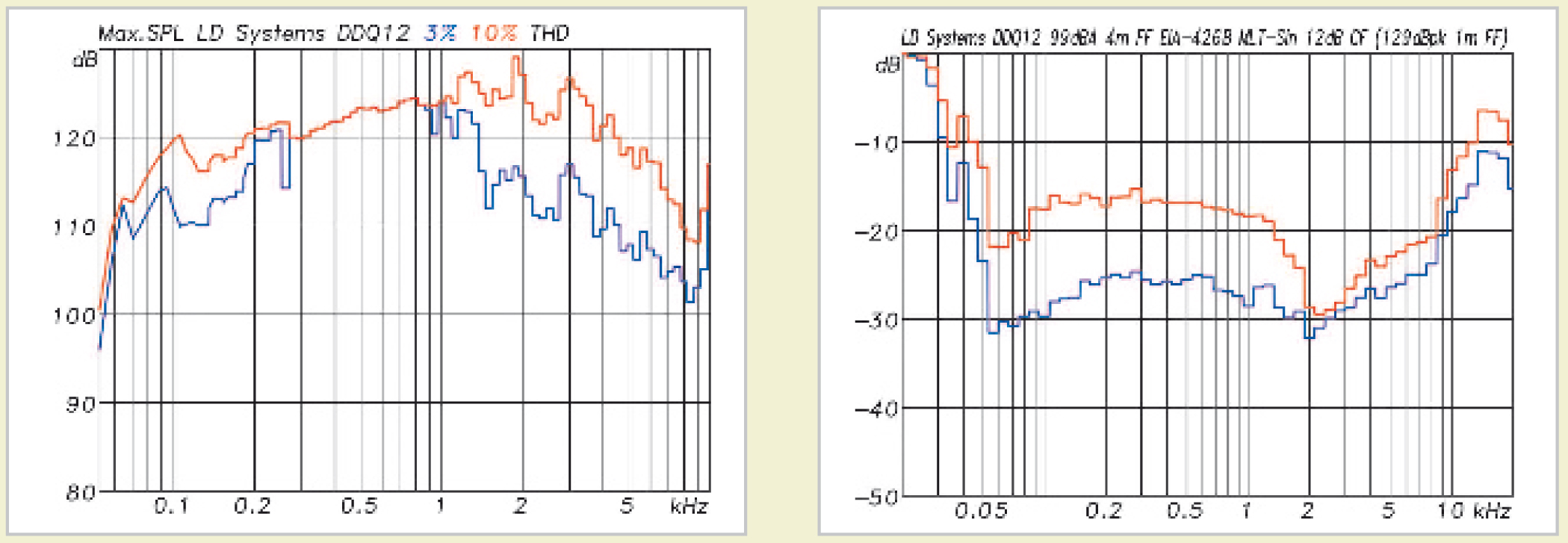
Fig. 11: Maximum level for max. 3% (blue) and max. 10% (red) distortion. For the woofer, the limiter takes effect above 200 Hz.
Fig. 12: Intermodulation distortion at 99 dB LAeq at 4 m (blue) and when the limiter becomes active (red), where the reading is then 102 dB LAeq at 4 m. The peak level LZpk attained with reference to 1 m distance is 129 dB.
Maximum possible SPL
The max. SPL was measured using the familiar procedure with a sinus burst of 185 ms in duration, in which the level is increased until a predefined distortion threshold is reached. In this case, the values were specified at 3% and 10% THD. In this regard, the DDQ12 evidences a type of textbook behaviour in Fig. 10: at low frequencies, the driver produces distortion with increasing deflection, so that the 3% and 10% clearly separate. From 200 Hz upwards then, a frequency range begins in which the deflection is no longer critical and the driver produces only a little distortion. Here the limiter kicks in, which is apparent from the converging curves for 3% and 10% THD. The 10% distortion is not reached in this range.
Above 1 kHz then, where the tweeter comes into play, the 3% and 10% curves are 10 dB apart. Compression drivers primarily generate non-critical k2 distortion components that increase quadratically with the level. This means that if the level increases by 10 dB, e.g., from 110 to 120 dB, and the distortion at 110 dB was 80 dB (3 %), then the distortion at 120 dB is 100 dB (10 %).
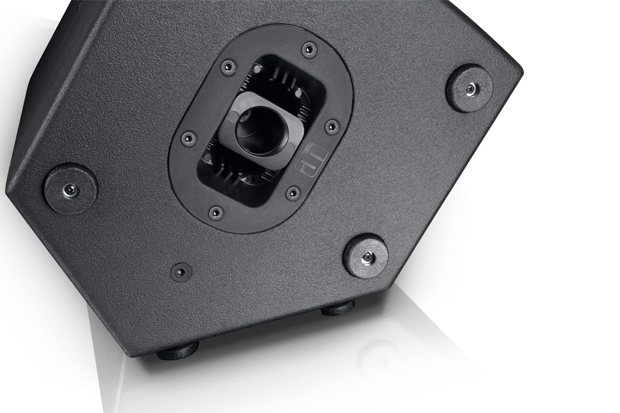
Fig. 13: Pole mount with an adjustable tilt angle of +/- 13.5°
A second distortion measurement deals with intermodulation distortion (IMD). Now, with the increasing number of speakers that we have tested, the method of measurement newly introduced recently in our tests at PRODUCTION PARTNER also permits initial comparative interpretations and evaluations. To this end, the speaker is loaded with a multisinus signal consisting of 60 sinus signals at an interval of 1/6 of an octave. The spectral composition of this signal corresponds to a mean music spectrum in accordance with EIA-426B and the crest factor is a practical 12 dB. Afterwards, we evaluate what components the speaker has generated for this signal that do not belong to the excitation signal – in other words, the distortion. These include the harmonic distortion of the sinus signals and all intermodulation products. For the DDQ12, the measurement was carried out for an average sound level LAeq of 99 dBA at a distance of 4 m. Converted, this is equivalent to a level of 111 dBA at 1 m. The peak value measured, LZpk, was 126 dB. If one drives the speaker all the way up to the clipping threshold of the amp, then the peak value increases to 129 dB at 1 m and the average level to 102 dBA.
The two curves clearly show that the woofer reaches its limits first, which is no surprise, since the tweeter already starts out with a 10 dB advantage in sensitivity. If the IMD curve is at –30 dB or less, then these are already superlative values for a speaker – values that are usually only attained by studio monitors. Values between –20 and –30 dB correspond to superior sound reinforcement quality. If the values increase across a wide band in ranges from –15 to –10 dB, then the speaker is reaching its limits. This is not the case here, not even at full load just before the limiter triggers.
Conclusion
The new DDQ Series from LD Systems will launch in spring 2013 with two active tops: the DDQ10 with a 10″+1″ configuration and the DDQ12, presented here, with a 12″+1″ configuration. Plans call for these to be supplemented with two subwoofers in time for Prolight + Sound (Hall 8, C48). In terms of workmanship and features, the DDQ12 meets the highest standards even when it comes to difficult and rigorous applications. The selection of the components, with Faital and BMS drivers, dual 400-watt Hypex power amplifiers, and a high-end DSP processor, clearly shows that the development process was dictated by the high standard of speaker quality. Accordingly, the result is really impressive. The measured values show good to very good results across the board, and in terms of sound, the DDQ12 is superlative right up to the limits, making it a genuine state-of-the-art high-end 12/2 speaker. This makes the recommended retail price of € 1,049 incl. VAT even more pleasing, almost sensational.
For additional product information, go to:
http://www.ld-systems.com/en/series/ddq-series
Source: Production Partner Magazine, Germany, April 2013
Author: Anselm Goertz
Leave a Comment
You must be logged in to post a comment.












